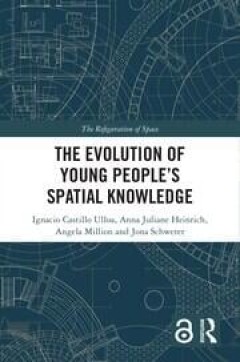Filter by

From Decoding Turbulence to Unveiling the Fingerprint of Climate Change
This open access book serves as a reference for the key elements and their significance of Klaus Hasselmann's work on climate science and on ocean wave research, all based on a rigorous and deeply physical thinking. It summarizes the original articles (mostly from the 1970 and 1980s; some of which are hard to find nowadays) and brings them in a present-day context. From 1975 until 2000, he was …
- Edition
- 1
- ISBN/ISSN
- 978-3-030-91716-6
- Collation
- -
- Series Title
- -
- Call Number
- XI, 315

The Evolution of Young People’s Spatial Knowledge
Young people imagine, perceive, experience, talk about, use, and produce space in a wide variety of ways. In doing so, they acquire and produce stocks of spatial knowledge. A quite dynamic and ever-changing process by nature, young people’s production and acquisition of spatial knowledge are susceptible to many kinds of conditions—from those that shape their everyday routines to those that …
- Edition
- -
- ISBN/ISSN
- 9781003099727
- Collation
- -
- Series Title
- -
- Call Number
- -

Pride Parades and LGBT Movements: Political Participation in an International…
The Open Access version of this book, available at https://www.tandfebooks.com/doi/view/10.4324/9781315474052, has been made available under a Creative Commons Attribution-Non Commercial-No Derivatives 4.0 license Today, Pride parades are staged in countries and localities across the globe, providing the most visible manifestations of lesbian, gay, bisexual, trans, queer and intersex movements…
- Edition
- -
- ISBN/ISSN
- 9781315474052
- Collation
- -
- Series Title
- -
- Call Number
- -

Zur Soziologie der Software
In diesem Open-Access-Buch stehen Software und ihre Rolle für das Soziale im Mittelpunkt. Die Arbeit stellt Grundprobleme und Lösungsansätze einer Soziologie der Software vor und skizziert damit eine soziologische Perspektive auf einen Forschungsgegenstand, der für das Verständnis digitalisierter Gesellschaften zentral ist. Dafür werden organisations- und techniksoziologische Forschu…
- Edition
- 1
- ISBN/ISSN
- 978-3-658-37256-9
- Collation
- -
- Series Title
- -
- Call Number
- IX, 269

Building Communities of Trust Creative Work for Social Change
Drawing upon a combination of ethnographic research and media and communication theory, Building Communities of Trust: Creative Work for Social Change offers pathways to building trust in a range of situations and communities. Ann Feldman presents rich examples from her own life and social-impact journey with nonprofit, Artistic Circles, along with supplemental case studies from interviews w…
- Edition
- -
- ISBN/ISSN
- 9781003296423
- Collation
- -
- Series Title
- -
- Call Number
- -

Sustainable Food Futures: Multidisciplinary Solutions
Securing sustainable food for everyone is one of the world's most pressing challenges, but research, policy, and programmes remain fragmented, and effective solutions have been slow to emerge. This book takes on these challenges by proposing a range of solutions that can advance pathways towards sustainable food futures. Complete with recipes, this book is structured so that readers are taken …
- Edition
- -
- ISBN/ISSN
- -
- Collation
- -
- Series Title
- -
- Call Number
- -

A People's History of Classics: Class and Greco-Roman Antiquity in Britain an…
A People’s History of Classics explores the influence of the classical past on the lives of working-class people, whose voices have been almost completely excluded from previous histories of classical scholarship and pedagogy, in Britain and Ireland from the late 17th to the early 20th century. This volume challenges the prevailing scholarly and public assumption that the intimate link betwe…
- Edition
- -
- ISBN/ISSN
- 9781315446608
- Collation
- -
- Series Title
- -
- Call Number
- -

Indigenous Knowledge Production: Navigating Humanity within a Western World
Despite many scholars noting the interdisciplinary approach of Aboriginal knowledge production as a methodology within a broad range of subjects – including quantum mathematics, biodiversity, sociology and the humanities - the academic study of Indigenous knowledge and people is struggling to become interdisciplinary in its approach and move beyond its current label of ‘Indigenous Studies�…
- Edition
- -
- ISBN/ISSN
- 9781315437811
- Collation
- -
- Series Title
- -
- Call Number
- -

Consciousness and Moral Status
It seems obvious that phenomenally conscious experience is something of great value, and that this value maps onto a range of important ethical issues. For example, claims about the value of life for those in Permanent Vegetative State (PVS); debates about treatment and study of disorders of consciousness; controversies about end-of-life care for those with advanced dementia; and arguments abou…
- Edition
- -
- ISBN/ISSN
- 9781315396347
- Collation
- -
- Series Title
- -
- Call Number
- -

Patient Self Referral: A Guide for Therapists
This exciting series is unique in providing advice on management, leadership and development for those in the Allied Health Professions (AHP). This practical and comprehensive guide contains all the information you need to set up a self referral service successfully, including answers to frequently asked questions, sample referral forms, a sample poster, datasets, guides for consistency, an ant…
- Edition
- -
- ISBN/ISSN
- 9781315382814
- Collation
- -
- Series Title
- -
- Call Number
- -
 Computer Science, Information & General Works
Computer Science, Information & General Works  Philosophy & Psychology
Philosophy & Psychology  Religion
Religion  Social Sciences
Social Sciences  Language
Language  Pure Science
Pure Science  Applied Sciences
Applied Sciences  Art & Recreation
Art & Recreation  Literature
Literature  History & Geography
History & Geography